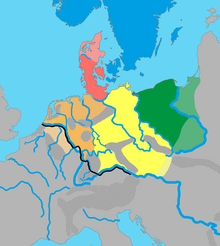Elbe Germanic peoples



The Elbe Germans (German: Elbgermanen) or Elbe Germanic peoples were Germanic tribes whose settlement area, based on archaeological finds, lay either side of the Elbe estuary on both sides of the river and which extended as far as Bohemia and Moravia, clearly the result of a migration up the Elbe river from the northwest in advance of the main Migration Period until the individual groups ran into the Roman Danube Limes around 200 AD.
Tribal affiliation
The Elbe Germans included the tribes of the Semnones, Hermunduri, Quadi, Marcomanni and the Lombards.[1] Historically they are possibly the same as the Irminones or Herminones mentioned by classical authors such as Tacitus, Pliny the Elder and Pomponius Mela. The most notable of these were the Suebic tribes.
All or most of the modern languages thought to derive from the languages of these historical peoples are in the High German group of the West Germanic language family.
By contrast with the settlement areas of the North Sea, Oder-Vistula and Rhine-Weser Germans (from which the Franks descended), there was a relatively uniform development in the economic and social spheres. This can be seen, for example, in the clear consistencies of material and intellectual culture (ceramics, appliances, weapons, jewellery, religious customs, etc.). This was due to the intensive contact between the Elbe Germanic tribes, as well as contact with other, more distant, Germanic tribes.
Links with the Jastorf culture have been made.
Based on the Roman sources, this cultural area was briefly united under Maroboduus (c. 30 BC—AD 37), a Romanized king of the Germanic Suebi.
History of research

The term 'Elbe Germanic' (German: Elbgermanen) was first used in 1868 by Paul Gustav Wislicenus (1847–1917), but it was especially popularized by the German prehistorian de:Walther Matthes in 1931.[2] The term was based initially on partially speculative derivations from ancient Roman sources.
For example, numerous Roman authors mentioned the tribes such as the Suebi and the Irminones, and some other Germanic tribes of the late antiquity on the Danube limes of the Roman Empire.
In the second half of the 20th century, more archeological evidence has emerged. In 1963, the Czech archaeologist Bedřich Svoboda took up the term and postulated an Elbe Germanic connection with the finds in Bohemia and Bavaria, which was later confirmed.[3]
Archaeological finds make it possible to differentiate between the different settlement areas of the Elbe Germanic tribes. There is a northern group around the mouth of the Elbe and in Mecklenburg-Vorpommern, a middle group in central Germany that reaches as far as the Oder, and a southern group in Bohemia, an area that was entirely Elbe-Germanic during the time of the Roman Empire.
Based on the linguistic and archaeological evidence, it is believed that the major Germanic tribes of the Alemanni, Thuringii, and the Bavarii mainly developed from the smaller Suebic groups that were part of the Elbe Germanic peoples.[4]
Elbe Germanic protolanguage
"Elbe Germanic", also called Irminonic, is a term introduced by the German linguist Friedrich Maurer in his 1942 book, Nordgermanen und Alemanen, to describe the unattested proto-language, or dialectal grouping, ancestral to the later Alemannic, Lombardic, Thuringian and Bavarian dialects.
See also
References
- ^ Walter Pohl: Die Germanen; Oldenbourg Wissenschaftsverlag, Munich, 2004, ISBN 9783486567557
- ^ Johannes Hoops, Heinrich Beck, Dieter Geuenich, Heiko Steuer: Reallexikon der germanischen Altertumskunde: Band 7; Walter de Gruyter, Berlin/New York 1989, ISBN 9783110114454
- ^ Thomas S. Burns: Barbarians within the gates of Rome: a study of Roman military policy and the barbarians, ca. 375-425 A.D, Indiana University Press, Bloomington 1994, ISBN 9780253312884
- ^ Heinrich Beck: Germanenprobleme in heutiger Sicht; Walter de Gruyter, Berlin/New York, 1999, ISBN 9783110164381
Literature
- Heinrich Beck, Gerhard Mildenberger: Elbgermanen. In the Lexicon of Germanic Antiquity Studies (Reallexikon der Germanischen Altertumskunde) (RGA). 2nd edition, Vol. 7, Walter de Gruyter, Berlin/New York 1989, p(p). 107–115.
